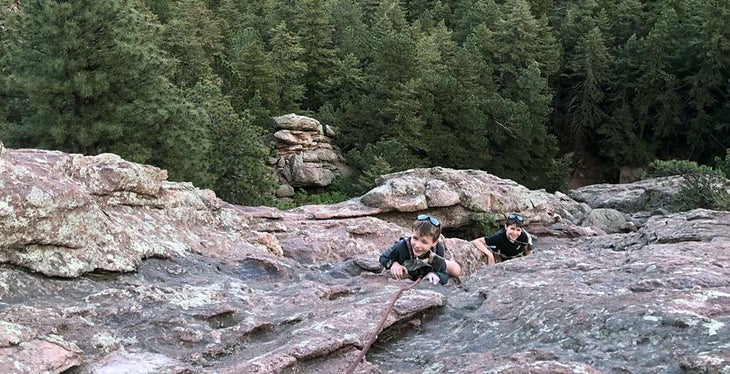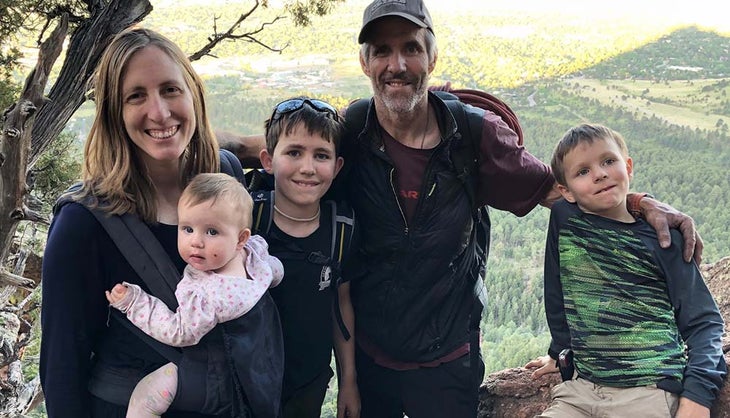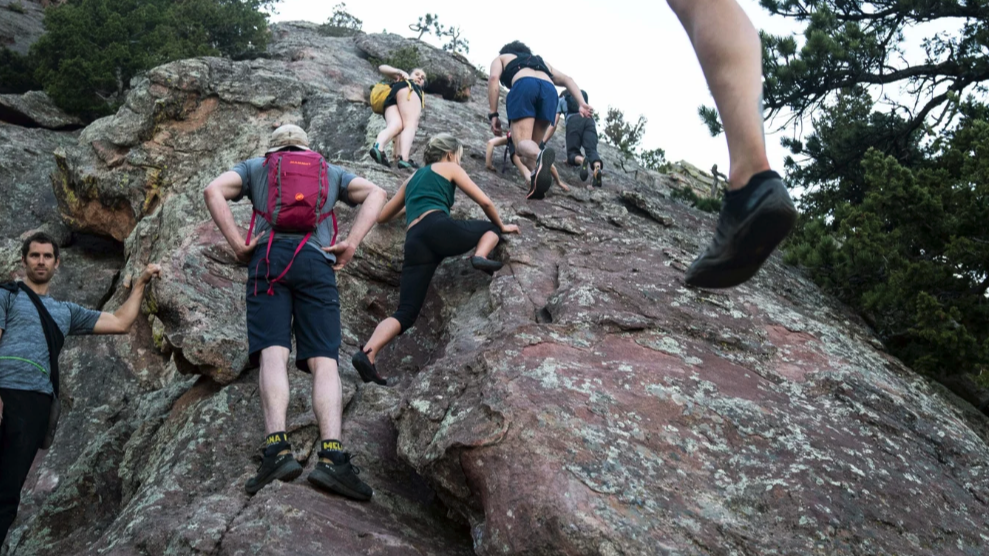No products in the cart.
Outdoor Adventure
A Reluctant Free Soloist Rescued On Her Lucky Day
I could see them soloing toward my belay 90 feet up the Second Flatiron outside Boulder, Colorado, a man and a woman, the woman shaky, sweaty, moving uncertainly, her feet clad in blown-out approach shoes. Nonchalant, her friend stood above her on the slab pointing out holds. “You’ve got this,” he’d say. “The next hold is a jug”—as if they were merely playing add-on at the bouldering gym. As if one missed move wouldn’t send her sliding down to crater, broken and ragdolled, where my wife sat nursing our baby in the shade of a rock. As if one missed move wouldn’t send her careering past my two boys, starting up toward me on the rope.
I used to think that the opening scene in Vertical Limit was far-fetched. I mean, how does one party fall down a face and strip off other climbers below? Or perhaps better: How often does this really happen?
Well, in the Flatirons, where group and “guided” free solos have become a thing, with hundreds of people doing the easiest east-face routes on the formations on a daily basis, I’m surprised it doesn’t happen more—or that I haven’t heard of it happening yet.

Picture a conga line of unroped climbers—ten of them, twenty!—in a row on a flat, inclined slab. Perhaps there’s a “trip leader,” a person who’s done the route before. Some climbers wear rock shoes, move well, and have experience; some wear approach shoes, laced up tightly; some wear running shoes—maybe it’s their first time doing this. And some (the scary ones) wear unlaced, white-soled tennis shoes that slide down a foot for every two feet of progress. As they catch themselves on a jug an instant before taking a lethal, 500-foot cartwheeling tumble, they turn to their friends and say, “That was sick!”
It’s a casual day out. I mean, if these things truly were dangerous, they wouldn’t be all over Instagram and Mountain Project and YouTube. Or the rangers would have fenced them off. No one ever dies soloing 45-degree slabs, right?
All the while, the reaper sharpens his blade.
As the two climbers came up on my belay, I flattened myself to let them pass. Seventy feet down, my boys bickered. I’d tied them in about 20 feet apart so I could belay them on the same rope, but they were moving at different paces: “Dad, Ivan’s pulling me off!” and “Dad, Alex is going way too slow!”
After decades of traffic, the first pitch of Freeway is polished, its cracks rounded smooth, the smears glassy. I’d worried that my boys would struggle there. I hollered down that I’d lower them and we could try a different start, one farther right with a gentler angle. After a couple of minutes, they were back on the ground. In the interim, the two climbers had passed me, climbing up into a wide, diagonalling crack. There the woman had frozen, her knee jammed in the fissure, her friend standing on a rounded ledge just above.
Back in my twenties and early thirties, I soloed the east faces of the First, Second, and Third Flatirons on a regular basis. They’re fun—you can cover hundreds of feet in minutes, earning brilliant views over Boulder and the Indian Peaks. I’d often link them with nearby bouldering and slot traverses for a full-body pump.
Free Soloing Means No Rope. These Climbers Have Defined the Pursuit.
Then, at a certain point, as I experienced increasing anxiety due to an insidious tranquilizer addiction, I began to have panic attacks during my solos. Bullheaded, I persisted anyway, until one day in 2005 on the direct east face of the First Flatiron, soloing with my friend Rolando, I had a meltdown 100 feet up. Rolo climbed up and right to suss a bailout, chalking holds for me. Trembling, hyperventilating, sweating, eyes popping, I clung to the grips until I reached a small ledge. As bad as the experience had been for me, it had to have been worse for Rolo—looking down, powerless, wondering if I was about to die, as seems to happen every year or so on these often underestimated formations.
“I’m not feeling this today,” the woman, still lodged in the crack, told her friend. “How much farther is it?”
“A long way,” he said with a chuckle.
“You know,” I said. “I have a rope and a harness here.” The woman looked down at me, considering her options. I gauged her trajectory were she to fall—a grinding, 15-foot slide right onto my belay. I had three good cams in, but still.
“I’m gonna bail,” she said. “I’m 100 percent not feeling this.”
“You’ve got this,” her friend said. “It’s not that bad.”
“How about we get her on a rope?” I said, before the conversation could go any further, before the unspeakable happened. Before her “friend” talked her into a very bad decision.
The woman slid down the crack, and I pulled her into my belay as the man soloed off. I pulled off my harness and helped her get it on, then clipped her in. It was her birthday, she told me, and she’d asked to be taken up the Second Flatiron as a gift. She was visiting from the Midwest and hadn’t been climbing much, plus she was feeling the altitude.
“I’m so mad at myself,” she said. “I really wanted to do this.”
“Don’t be,” I said. “I’ve been gripped on these faces more times than I can remember”—and I told her the stories. “It happens to us all,” I said as she rappelled. “I’m just glad you’re OK.”
My boys and I summited the Second Flatiron that day, climbing seven pitches to where Freeway steps down off a small spire onto the trail. It was a hot late-May day, but as the air cooled and the shadows of the Flatirons crept out over the ponderosa, the formation got busier and busier, until on the final two pitches we were stopping to let huge packs of soloists go by. Everyone was friendly and encouraging of the boys (“I wish my dad had done this with me”), but it was a shit show, and not all the climbers were dialed, many moving with hesitation.
As we met my wife and daughter at the notch, my younger boy, Alex, breathlessly began to recount our adventure. He’d slipped on a water-polished groove on the fifth pitch, and I’d caught him—a very short fall. “The rope saved my life!” he exclaimed. “Those people without ropes are stupid.”
I wasn’t sure what to say—I’d essentially soloed the route, too, dragging the cord behind me to belay up my boys on each pitch. But I’d felt solid, I supposed; we all do, until our foot slips. It’s kind of like what Mike Tyson famously said: “Everyone has a plan until they get punched in the mouth.”

Source link

